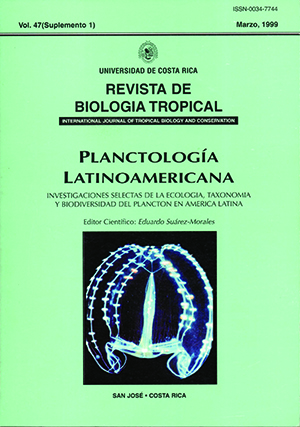Abstract
The relation among bacteriopbnkton, nannoplankton. microzooplankton, and some abiotic factors in the oligotrophic oceanic water, of northern Cuba was analyzed. Samples were obtained at three different depths from 40 stations during February 1997. Nannoplankton, microplankton and bacterial biomass were determined by standard methods, including ceH counting and epifluorescence microscopy. The spatial distribution pattcrn uf hcterotrophíc components showed a higher richness at western and eastern zones of the studied region, as in areas near La Habana and Matanzas bays. From the surface layer to 1% irradiance depths, the highest relative contribution was of microzooplankton and bacterioplanklon, whereas the mixed (thermocline) layer was dominated by nannoplankton. The dynamic regime characteristic of this zone and the effect of enriched water from shelf and bays has influence on the behavior of the planktic fractions.
References
Beaver, J. & T. Crisman. 1982. The trophic response of ciliated protozoans in freshwater lakes. Limnol. Oceanogr. 27: 246-253.
Caron, D. A. 1983. Technique for enurneration of heterotrophic and phototrophic nanoplankton, using epifluorescence microscopy, and comparison with other procedures. Appl. Environ. Microbiol. 46: 491-498.
Frontier, S. 1969. Sur une methode d'ana!yse faunistiquerapide du zooplancton. J. Exp. Mar. Biol. Ecol. 3: 18-26.
García, C. 1991. Corriente geostrófica del norte de Cuba. Informe Interno Archivo Científico del Centro de Investigaciones Pesqueras, La Habana. 16p.
Hobbie, J.H., RJ. Daley & S. Jasper. 1977. Use of nucleopore filters for counting bacteria by epifluorescence microscopy. Appl. Environ. Microbiol. 33: 1225-1228.
Hondeveld, B.J.M., R.P. Bak & F.C. Van Duyl. 1992. Bacteriovory by heterotrophic nanoflagellates in marine sediments measured by uptake on fluorescently labeled bacteria. Mar. Ecol. Prog. Ser. 89: 63-71.
Leakey, R., G. Burkill & M. Sleigh. 1994. Ciliate growth rate from Plymouth Sound: Comparison of estimates. J. Mar. Biol. Ass. UK. 74:849-861.
Lugioyo, M. 1996. Distribución espacio-tempora! del bacterioplancton en las aguas oceánicas al sur de Cuba. Tesis de Maestría, Universidad de la Habana, Ciudad de la Habana, Cuba.
Lugioyo, M & S. Loza. 1997. Distribución espacial del bacterioplancton, cianobacterias y nanoplancton en las aguas oceánicas al norte de Cuba, durante la época de invierno. Rev. lnv. Mar. 18:89-98.
Orozco, M. Y. ! 997. Microzooplancton en las aguas oceánicas al sur de Cuba. Tesis de Maestría, Universidad de la Habana, Ciudad de la Habana, Cuba.
Scheda, S.M. & B.C. Cowell. 1988. Rotífer grazers and phytoplankton. Seasonal experirnents on natural communities. Arch. Hydrobiol. 114: 31-44.
Sherr, B. F., E.B. Sherr & C.S. Hopkinson. 1988. Trophic interactions within pelagic microbial cornmunities: indications of feedback regulation of carbon flow. Hydrobiologia 159: 19-26.
Sieburth, J.McN. & P.G. Davis. 1982. T he role of heterotrophic nannoplankton in the grazing and nurturing of planktonic bacteria in the Sargasso and Caribbean Seas. Ann. Inst. Oceanogr. Paris. 58: 285-296.
Stockner, J. 1988. Phototrophic picoplankton: an overview from marine and freshwaters ecosystems. Limnol. & Oceanogr. part 2, 33:765-775.
Stoecker, D.K., M.E. Sieracki, P.G. Verity, A.E. Michaels, E. Haugen, P.H. Burkill & E. Eduards. 1994. Nannoplankton and protozoan microzooplankton during the J60FS North Atlantic bloom experiment: 1989 and 1990. J. Mar. Biol. Ass. U.K. 74:427-443.
Strickland, J.D.H. & T.R. Parsons. 1972. A practical handbook of seawater analysis. Bull. Fish. Res. Board. Can. 167: 1-310.
Comments

This work is licensed under a Creative Commons Attribution 4.0 International License.
Copyright (c) 1999 Revista de Biología Tropical


